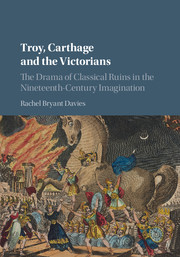 Troy, Carthage and the Victorians
Troy, Carthage and the Victorians Published online by Cambridge University Press: 03 March 2018
Marius sat thinking … I suppose he was reflecting how grand cities may fall, as Carthage did, and how powerful statesmenmay also fall from their high estate, as he himself had done.
F. J. Gould, The Children's Plutarch: Tales of the Romans (1910) 75.[T]he days of England's glory have their number, and the period of her decline will at length arrive.
John Chetwode Eustace, Classical Tour (1813) I, 23–4.On 6 March 1856, Londoners woke to the news that ‘the Royal Italian Opera House, Covent-garden, was totally destroyed by fire’. Twenty-five fire engines had prevented this conflagration from spreading; however, unlike in Dibdin's Troy, there was no reprieve from the flames. The Illustrated London News immediately devoted several pages to the fire-fighters in action and the Queen's tour of the strikingly ancient-looking ruins (Figure 5.17). Yet this traumatic event, like the controversy over the Society of Antiquaries's request for funding to excavate Troy, would remain potent in the public imagination: further images of the fire circulated and, just over a year later, ‘a serio-comic opening address’ written by Robert Brough – who would soon write the Lyceum's Siege of Troy – was the ‘gem of the evening’ at opening night festivities nearby. Brough turned the Italian Opera's destruction to comic account in comparing the manager as a young actor to:
A stray oyster in an empty barge.
Or Marius – Mario – I beg your pardon,
Sitting among the bricks of Covent Garden.
At first sight, this burlesque joke, like those we saw in the previous chapter, simply exploits outrageous anachronisms to conflate past and present. It is no surprise that Brough's allusion – to the consul Caius Marius in exile among the ruins of Carthage – and his humorously pedantic linguistic correction distinguishes between spectators who did, or did not, know their Classics.
This chapter will explain why Brough's choice of this specific comparison to Carthage is neither random nor superficial.
To save this book to your Kindle, first ensure no-reply@cambridge.org is added to your Approved Personal Document E-mail List under your Personal Document Settings on the Manage Your Content and Devices page of your Amazon account. Then enter the ‘name’ part of your Kindle email address below. Find out more about saving to your Kindle.
Note you can select to save to either the @free.kindle.com or @kindle.com variations. ‘@free.kindle.com’ emails are free but can only be saved to your device when it is connected to wi-fi. ‘@kindle.com’ emails can be delivered even when you are not connected to wi-fi, but note that service fees apply.
Find out more about the Kindle Personal Document Service.
To save content items to your account, please confirm that you agree to abide by our usage policies. If this is the first time you use this feature, you will be asked to authorise Cambridge Core to connect with your account. Find out more about saving content to Dropbox.
To save content items to your account, please confirm that you agree to abide by our usage policies. If this is the first time you use this feature, you will be asked to authorise Cambridge Core to connect with your account. Find out more about saving content to Google Drive.